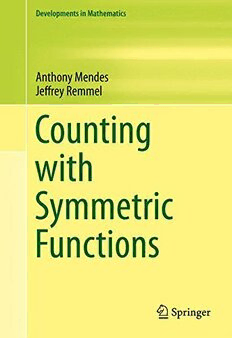Table Of ContentDevelopments in Mathematics
Anthony Mendes
Jeffrey Remmel
Counting
with
Symmetric
Functions
Developments in Mathematics
VOLUME43
SeriesEditors:
KrishnaswamiAlladi,UniversityofFlorida,Gainesville,FL,USA
HershelM.Farkas,HebrewUniversityofJerusalem,Jerusalem,Israel
Moreinformationaboutthisseriesathttp://www.springer.com/series/5834
Anthony Mendes • Jeffrey Remmel
Counting with Symmetric
Functions
123
AnthonyMendes JeffreyRemmel
MathematicsDepartment DepartmentofMathematics
CaliforniaPolytechnicStateUniversity UniversityofCaliforniaatSanDiego
SanLuisObispo,CA,USA LaJolla,CA,USA
ISSN1389-2177 ISSN2197-795X (electronic)
DevelopmentsinMathematics
ISBN978-3-319-23617-9 ISBN978-3-319-23618-6 (eBook)
DOI10.1007/978-3-319-23618-6
LibraryofCongressControlNumber:2015953218
MathematicsSubjectClassification(2010):05A05,05E05,05A15,05A19,05E18
SpringerChamHeidelbergNewYorkDordrechtLondon
©SpringerInternationalPublishingSwitzerland2015
Thisworkissubjecttocopyright.AllrightsarereservedbythePublisher,whetherthewholeorpartof
thematerialisconcerned,specificallytherightsoftranslation,reprinting,reuseofillustrations,recitation,
broadcasting,reproductiononmicrofilmsorinanyotherphysicalway,andtransmissionorinformation
storageandretrieval,electronicadaptation,computersoftware,orbysimilarordissimilarmethodology
nowknownorhereafterdeveloped.
Theuseofgeneraldescriptivenames,registerednames,trademarks,servicemarks,etc.inthispublication
doesnotimply,evenintheabsenceofaspecificstatement,thatsuchnamesareexemptfromtherelevant
protectivelawsandregulationsandthereforefreeforgeneraluse.
Thepublisher,theauthorsandtheeditorsaresafetoassumethattheadviceandinformationinthisbook
arebelievedtobetrueandaccurateatthedateofpublication.Neitherthepublishernortheauthorsor
theeditorsgiveawarranty,expressorimplied,withrespecttothematerialcontainedhereinorforany
errorsoromissionsthatmayhavebeenmade.
Printedonacid-freepaper
SpringerInternationalPublishingAGSwitzerlandispartofSpringerScience+BusinessMedia(www.
springer.com)
Preface
Thisbookisabouthowsymmetricfunctionscanbeusedinenumeration.Thedevel-
opmentisentirelyself-contained,includinganextensiveintroductiontotheringof
symmetricfunctions.Manyoftheproofsarecombinatorialandinvolvebijectionsor
sign-reversinginvolutions.Therearenumerousexerciseswithfullsolutions,many
ofwhichhighlightinterestingmathematicalgems.
The intended audience is graduate students and researchers in mathematics or
related subjects who are interested in counting methods, generating functions, or
symmetricfunctions.Themathematicalprerequisitesarerelativelylow;weassume
the readers possess a knowledge of elementary combinatorics and linear algebra.
Weusethebasicideasofgrouptheoryandringtheorysparinglyinthebook,using
themmostlyinChapter6.
Chapter 1 introduces fundamental combinatorial objects such as permutations
and integer partitions. Statistics on permutations an(cid:2)d(cid:3)rearrangements are defined
andrelationshipsbetweenq-analoguesofn,n!,and n aregiven,astheseareused
k
inlaterchapters.Wealsoprovideanintroductiontogeneratingfunctions.Muchof
thematerialinthisintroductorychapterisclassic.
SymmetricfunctionsareintroducedinChapter2.Ourdevelopmentemphasizes
thecombinatoricsofthetransitionmatricesbetweenbasesofsymmetricfunctions
in a way that cannot be found elsewhere. Readers may find this approach more
accessiblethanthoseinotherbooksthatdiscusssymmetricfunctions.Thismaterial
isessentialtounderstandingthelaterchaptersinthebook;afterall,thisbookisall
abouthowtousetherelationshipsbetweensymmetricfunctionstosolvecounting
problems.
One of the major ideas this book highlights is that ring homomorphisms ap-
plied to the ring of symmetric functions can be used to find interesting generating
functions.ThisisfirstappliedinChapter3,whereweusethebackgroundmaterial
introduced in Chapters 1 and 2 to find an assortment of generating functions for
permutation statistics. We are able to count and refine permutations according to
restrictedappearancesofdescentsandproveanumberofresultsaboutwords.
v
vi Preface
InChapter4,thetechniquesintroducedinChapter3areextendedtofindgener-
atingfunctionsforavarietyofobjects.Theexponentialformulaandthegenerating
functionsderivedfromlinearrecurrenceequationscanbefoundwiththemethods
introducedinChapter4.
The Robinson-Schensted-Knuth algorithm is presented in Chapter 5, an impor-
tantalgorithmwhichneedstobeincludedinanybookonsymmetricfunctionsand
enumeration.Connectionsaremadetoincreasingsubsequencesinpermutationsand
words and the Schur symmetric functions. A q-analogue of the celebrated hook
lengthformulaisproved.
Symmetric functions are used to prove Po´lya’s enumeration theorem in Chap-
ter 6, allowing us to count objects modulo symmetries. This is a standard topic in
manycoursesoncombinatorics,buttoooftenitisnotmadeclearthatPo´lya’senu-
meration theorem can be properly phrased using the language of symmetric func-
tions. We also give a new combinatorial proof of the Murnaghan-Nakayama rule
fromthePierirules.
Chapters7and8aremorespecializedchaptersthantheothers,andmayappeal
to researchers in this area. In Chapter 7 we study consecutive pattern matches in
permutations,words,cycles,andalternatingpermutations.Chapter8introducesthe
reciprocitymethod,anapproachwhichcanprovideawaytodefineringhomomor-
phismswithdesirableproperties.
MostoftheresultsandexercisesfoundinChapters3,4,7,and8areappearing
inbookformforthefirsttime.
Thechapterdependencychartforthetextisasfollows:
Chapter 1
Chapter 2
Chapter 3 Chapter 5
Chapter 4 Chapter 6
Chapter 7
Chapter 8
Anthony Mendes thanks Jeff Remmel for introducing him to some wonder-
ful mathematics and for working with him over the years. He thanks all students
who took Math 435 or Math 530 in the fall of 2014 at Cal Poly San Luis Obispo
for carefully reading a preliminary copy of this text. Thanks also go to the fol-
lowing people who pointed out at least one typographical error or suggested a
specific improvement to the text: Shelby Burnett, Maggie Conley, Saba Gerami,
MikeLaMartina,AmandaLombard,ThomasStienke,andThomasJ.Taylor.Most
Preface vii
importantly,AnthonyMendesthankshiswifeAmyanddaughtersAva,Tabitha,and
Rubyfortheirsupport.
JeffRemmelwouldliketothankAdrianoGarsia,DomiqueFoata,andIanMac-
donald who introduced him to the theory of symmetric functions and enumerative
combinatorics. He also thanks the following Ph.D. students who helped him over
theyearstodeveloppartsofthetheorypresentedinthisbook:TamsenWhitehead,
Diseree Beck, Tom Langley, Jennifer Wagner, Tony Mendes, Amanda Riehl, Jeff
Liese,EvanFuller,AndyNiedermaier,AndreHarmse,MilesJones,AdrianDuane
andQuangBach.Finally,hethankshisfamilymembers,especiallyhiswifePaula,
fortheircontinuingsupportwhichmadehisresearchcareerpossible.
SanLuisObispo,CA,USA AnthonyMendes
SanDiego,CA,USA JeffreyRemmel
July2015
Contents
1 Permutations,Partitions,andPowerSeries ....................... 1
1.1 PermutationsandRearrangements ............................ 1
1.2 IntegerPartitionsandTableaux ............................... 8
1.3 GeneratingFunctions ....................................... 12
Exercises ...................................................... 19
Solutions ...................................................... 22
Notes ......................................................... 30
2 SymmetricFunctions ........................................... 33
2.1 StandardBasesforSymmetricFunctions....................... 33
2.2 RelationshipsBetweenBasesforSymmetricFunctions........... 42
2.3 TransitionMatrices ......................................... 47
2.4 AScalarProduct ........................................... 56
2.5 TheωTransformation ...................................... 60
Exercises ...................................................... 66
Solutions ...................................................... 69
Notes ......................................................... 77
3 Counting with the Elementary and Homogeneous Symmetric
Functions ..................................................... 79
3.1 CountingDescents ......................................... 79
3.2 ChangingBrickLabels...................................... 89
Exercises ......................................................101
Solutions ......................................................106
Notes .........................................................119
4 CountingwithNonstandardBases ...............................121
4.1 TheBasis pν,λ.............................................121
4.2 CountingwiththeElementaryand pν,n ........................123
4.3 Recurrences ...............................................129
ix

